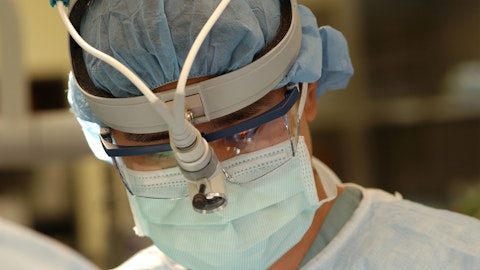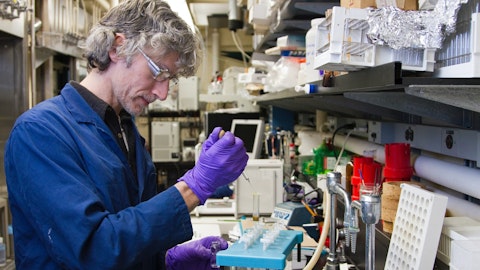The Cooper Companies, Inc. (NYSE:COO) Q4 2022 Earnings Call Transcript December 8, 2022
The Cooper Companies, Inc. misses on earnings expectations. Reported EPS is $2.75 EPS, expectations were $3.11.
Operator: Good afternoon, and welcome to Cooper Companies Fourth Quarter 2022 Earnings Conference Call. . I would now like to turn the call over to Kim Duncan, Vice President of Investor Relations and Risk Management. Please go ahead, Ms. Duncan.
Kim Duncan: Good afternoon, and welcome to The Cooper Companies fourth quarter and full year 2022 earnings conference call. During today’s call, we will discuss the results and guidance included in the earnings release and then use the remaining time for questions. Our presenters on today’s call are Al White, President and Chief Executive Officer; and Brian Andrews, Chief Financial Officer and Treasurer. Before we begin, I’d like to remind you that this conference call contains forward-looking statements, including all revenue and earnings per share guidance and other statements regarding anticipated results of operations, market or regulatory conditions or trends, product launches, operational initiatives, regulatory submissions and closing or integration of any acquisitions or their anticipated benefits.

Photo by Austin Distel on Unsplash
Forward-looking statements depend on assumptions, data or methods that may be incorrect or imprecise and are subject to risks and uncertainties. Events that could cause our actual results and future actions of the company to differ materially from those described in forward-looking statements are set forth under the caption forward-looking statements in today’s earnings release and are described in our SEC filings, including Cooper’s Form 10-K and Form 10-Q filings all of which are available on our website at coopercos.com. Also as a reminder, the non-GAAP financial information we will provide on this call is provided as a supplement to our GAAP information. We encourage you to consider our results under GAAP as well as non-GAAP and refer to the reconciliations provided in our earnings release, which is available on the Investor Relations section of our website under quarterly results.
Should you have any additional questions following the call, please e-mail ir@cooperco.com. And now I’ll turn the call over to AL for his opening remarks.
See also 15 Most Trusted Companies in the World and 11 Undervalued Canadian Stocks To Buy
Albert White: Thank you, Kim, and welcome, everyone, to Cooper Companies Fourth Quarter and Fiscal 2022 Year-end Conference Call. We finished this year with CooperVision reporting its seventh consecutive quarter of double-digit organic revenue growth and CooperSurgical, posting an eighth consecutive quarter of double-digit organic revenue growth within its fertility business. Demand for our products and services was very strong in Q4, and we’re seeing that continue into fiscal 2023. I’m extremely proud of the dedication of our Cooper employees and the hard work it took to post another year of record revenues in fiscal 2022, and I look forward to another record-setting year in fiscal 2023. Moving to the numbers. Consolidated quarterly revenues reached an all-time high of $848 million, and we closed the fiscal year with record revenues of $3.31 billion.
CooperVision posted quarterly revenues of $562 million, up 11% organically and reached a new record high of $2.24 billion in fiscal year revenues. CooperSurgical posted record quarterly revenues of $286 million, up 15% organically and reached new record fiscal year revenues of $1.07 billion. For the quarter, CooperVision’s growth was led by our daily silicone hydrogel portfolio and myopia management products, while CooperSurgical’s growth was broad-based with strength in PARAGARD fertility and our broader medical device portfolio. Non-GAAP earnings per share were $2.75. This was lower than we were forecasting primarily due to commercial spending tied to product launches and elevated distribution costs and Brian will cover this later in the call.
For CooperVision in Q4 and reporting all percentages on an organic basis, revenue growth was strong and diversified in all geographic regions and across all product categories, spheres, torics and multifocals. The Americas grew 5%, EMEA was up 13% and Asia Pac reached 16%. This performance was driven by new product launches, expanded product ranges, market-leading flexibility through our customized offerings and growth in key accounts. Regarding product details, daily silicone hydrogel lenses grew 20% with especially strong growth from MyDay and from clariti in the Asia Pac region. Daily silicones continue to be the main driver of growth for the contact lens industry, and we offer the broadest portfolio in the market with MyDay and clariti available on a broad range of spheres, towards and multifocals.
Our silicone hydrogel FRP lenses, Biofinity and Avaira, reported another solid quarter of 6% growth. Regarding product launches, we remain extremely active. The MyDay multifocal launch is going incredibly well, and the feedback from customers and practitioners remains outstanding. In the meantime, the MyDay toric parameter expansion launch has been overwhelmingly positive in the U.S. and Canada. With over 4,000 SKUs, we now match our standard Biofinity toric range and have the widest daily toric range in the market by a wide margin. Not only does this expand the daily toric category for everyone but for many FRP toric wears, this is their first opportunity to enjoy the freedom of a daily contact lens. We’ll be rolling out these expanded parameters in additional markets as we move through fiscal 2023 and look forward to continued success.
And lastly, on MyDay, we’re excited to be bringing MyDay Energies to the market. This lens uses the same innovative technology as Biofinity Energys to alleviate digital eye strain, and eye care practitioners are excited to be getting this technology in a premium daily offering. We started seeding the U.S. market and a full national rollout is scheduled for early spring. Combining all this MyDay activity, truly exemplifies CooperVision’s leadership in the daily silicone hydrogel space and our focus on offering practitioners a wide variety of market-leading technologically superior products. Outside of MyDay, demand for Biofinity remains especially strong to the point where we’re somewhat capacity constrained. We’ve increased price and production, especially in the extremely high demand made-to-order extended range torts and tour multifocals, and we’ll continue to focus on increasing capacity on a broader scale moving forward.
Moving to myopia management. We posted revenues of $26 million, up 29%, including MiSight up 88%. For the full fiscal year, we reported myopia management revenues of $93 million, which was impressive given the negative impact of currency and ongoing COVID restrictions in China. For MiSight, we’re rolling out an expanded parameter range and launching in new countries and I’m happy to report that MiSight is now available in 41 countries. Within this, we’re seeing increased fitting activity from both independent optometrists and key accounts and we’re continuing to see a positive halo effect with our MiSight customers accelerating their use of other CooperVision lenses. All this is a good sign and points to a strong fiscal 2023, where we expect myopia management revenue of $120 million to $130 million, up roughly 35% at the midpoint in constant currency.
As a reminder, MiSight contact lenses are the first and only FDA-approved soft contact lens proven to slow the progression of myopia in children aged 8 to 12 at the initiation of treatment. The product is backed by extensive clinical data and remains a shining example of CooperVision’s leadership in the contact lens industry. Moving to SightGlass. We’ve been making progress with these myopia control glasses as part of our great joint venture with EssilorLuxottica. This includes selling in China and pilot programs in Canada, the Netherlands, the U.K. and Israel. In the U.S., the JV submitted an FDA application to be the first spectacle lens product to receive FDA approval for myopia control, and we hope to receive a positive response by calendar year-end.
And to conclude on the importance of myopia management and why it needs to become standard of care, the risk of visual impairment and eye complications such as glaucoma, grows exponentially with vision loss. So preventing higher levels of myopia is critically important for the long-term health of our children’s eyes. To finish on CooperVision, the contact lens market is performing exceptionally well with growth of roughly 9% in calendar Q3. There are still COVID-related challenges, especially with respect to staffing shortages in optometry offices negatively impacting patient flow, but progress is being made. Meanwhile, the long-term growth drivers of the industry remain intact. This starts with a macro growth trend and more people needing vision correction with an estimated 50% of the global population expected to have myopia or nearsightedness by 2050, up from roughly 34% of the population today.
This is driven by a variety of factors, including greater levels of screen time and less time outdoors, especially among children. Other industry drivers include the market’s continuing shift to silicone hydrogel dailies, the increasing focus on higher-value products such as torics and multifocals and higher pricing, which is running ahead of historical trends. We expect global growth to remain healthy and believe we’ll remain a leader with our robust product portfolio, ongoing product launches, fast-growing myopia management business and leading New Fit Data. Moving to CooperSurgical. We posted a great quarter with growth throughout our portfolio. Fertility reported sales of $109 million, up 15% organically, its eighth consecutive quarter of double-digit organic growth.
success we’ve seen throughout the product portfolio and around the world. And given our momentum as we enter fiscal 2023, we’re continuing to invest in our team and in our fantastic product portfolio which includes leading consumables, capital equipment and genomics. Demand remains very strong, especially among our key accounts, so we need to keep building infrastructure, investing in our people and delivering the products and services required in this high-growth market. Regarding the overall fertility market, the future looks bright. There are several industry growth drivers, but one of the key factors being women delaying childbirth. The average age of a women’s first birth in the U.S. and several other developed countries now stands at a record high of 30 years old and age is one of the key factors in meeting fertility assistance.
Additionally, factors such as improving access to treatment, increasing patient awareness, improved product offerings such as cryopreservation, increasing fertility benefits coverage and technology improvements for both male and female and fertility are driving the industry forward. In total, it’s estimated that roughly 15% of reproductive age couples have fertility challenges and that over 750,000 babies are born annually through fertility assisted measures, and these numbers are growing. Regarding CooperSurgical’s market positioning, we compete in a portion of the market that’s roughly $2 billion in annual sales, and we forecast growth of 5% to 10% for many years to come. Within this, we’re well positioned to continue delivering strong results with the broadest portfolio in the industry, a market-leading commercial footprint and strike in key accounts.
Moving to office and surgical products, which includes OB/GYN Medical Devices, PARAGARD and stem cell storage. We posted sales of $178 million, up 58% and up 15% organically. Within this, PARAGARD grew 19% and office and surgical medical devices were up 13%. PARAGARD posted strong results rebounding from several tough quarters, and our OB/GYN medical devices benefited from strong demand, especially for surgical products combined with clearing and backlog. Lastly, our stem cell storage business grew 2%, in line with expectations against the difficult comp. To conclude on CooperSurgical, we made a ton of progress this year. Our fertility business continues to post great results. Our office and surgical products closed the year strong, and we completed an incredible amount of integration activity associated with several acquisitions, including the Generate deal.
Before I turn the call over to Brian, let me say this was a great fiscal year for Cooper. We reported record revenues and made significant advancements throughout our organization. As we enter fiscal 2023, demand remains strong, supported by stable consumer activity and price increases, our investment activities, including new product launches and capacity expansion are going well. Our employees are highly engaged, and we’re continuing to execute on our long-range strategic objectives. Having said that, we are aware of global inflation, geopolitical risks and other factors that could cause a global recession, and we’re thus managing our investment activity with prudent cost controls and will continue to be vigilant in our operations. With that, let me turn the call over to Brian.
Brian Andrews: Thank you, AL, and good afternoon, everyone. Most of my commentary will be on a non-GAAP basis, so please refer to our earnings release for a reconciliation of GAAP to non-GAAP results. Fourth quarter consolidated revenues were $848 million, up 12% as reported and organically. Consolidated gross margin was 65%, down 250 basis points from last year, primarily due to currency and higher costs associated with supply chain challenges. Operating expenses grew 12% and were 42.8% of revenues, primarily as a result of the acquisition of Generate. Consolidated operating margin was 22.2%, down from 24.9% last year, primarily due to currency. Before moving on, let me say our Q4 operating income did not meet expectations.
The primary drivers were commercial spending tied to product launches an elevated distribution costs tied to shipping and inefficiencies associated with capacity expansion and automation efforts. Some of this activity will continue in fiscal 2023, and I’ll touch on that in guidance. Below — moving below operating income. Interest expense was $23 million with higher rates and debt balances driving the increase. The effective tax rate was 14.2% and non-GAAP EPS was $2.75, with roughly 49.6 million average shares outstanding. Regarding earnings, FX negatively impacted the quarter by $0.75, which was $0.11 more than we had built into our guidance on our September earnings call. A large part of the $0.11 was attributable to the remeasurement of foreign currency-based intercompany trade receivables, including exposures from before we begin mitigating certain balances.
Free cash flow was $36 million, including CapEx of $95 million tied to capacity expansion and net debt reduced by $31 million to $2.61 billion. Moving to fiscal 2023 guidance. We are assuming a modest recession, ongoing inflation and rising interest rates. For the year, we’re guiding to consolidated revenues of $3.455 billion to $3.515 billion, up 6% to 8% organically, with CooperVision revenues of $2.325 billion to $2.365 billion, up 7% to 9% organically. And CooperSurgical revenues of $1.13 billion to $1.15 billion, up 4% to 6% organically. Non-GAAP EPS is expected to be in the range of $12.30 to $12.60 based on $106 million of interest expense and a 15% effective tax rate. For interest, we’re assuming a 50 basis point rate increase from the Fed in December, another 50 basis point increase in February and then an additional 25 basis point increase in March.
For the tax rate, we’re assuming no discrete items. For currency, we’re using yesterday’s rates with a little conservatism given the FX volatility. This results in year-over-year FX headwind of roughly 2.5% to revenues while being neutral to EPS. From a quarterly gating perspective, we expect consolidated Q1 revenues and earnings to be slightly less than Q4 with currency continuing to have a significant negative impact. After Q1, assuming rates hold steady, the currency impact will lessen and ultimately turn positive towards the middle of the fiscal year. Moving to the full year P&L. Let me touch on the details that will drive our financial results. During Q4, we ramped up investment activity and expect that to continue. As an example, we accelerated work on roughly doubling our U.S. CooperVision distribution center to get the building shell done before winter, and we now expect to be utilizing this additional 150,000 square feet of space this coming summer.
We are also expanding other distribution and manufacturing locations at CooperVision and CooperSurgical and implementing substantial automation. Additionally, we’re adding significant capacity to our contact lens manufacturing footprint. We saw some of this activity in Q4 with CapEx of $95 million, and we expect it to continue with CapEx being around $400 million this fiscal year. Near-term demand is strong and long-term growth trends are very positive. So this activity is needed to support our growth initiatives. Having done this type of expansion work in the past, we know we’ll get it done and probably ahead of schedule, but it does create inefficiencies. When you’re dealing with an already strained global supply chain, it makes things even more difficult.
We built expectations around this inefficiency into our guidance, along with inflation assumptions and believe we’ve sufficiently captured everything. In total, for fiscal 2023, this means strong revenue growth, slightly improving gross margin supported by price increases and higher than normal OpEx, resulting in our operating margin being up slightly year-over-year. To conclude on guidance, note that this does not include the pending acquisition of Cook Medical’s reproductive health business, but does include the acquisition of synergized a small specialty contact lens business we closed on November 1. Regarding Coke, we’re exploring options to get regulatory approval, including the potential sale of certain Cook assets and are hoping to close by June 30, 2023.
And with that, I’ll hand it back to the operator for questions.
Q&A Session
Follow Cooper Companies Inc. (NYSE:COO)
Follow Cooper Companies Inc. (NYSE:COO)
Operator: . Our first question comes from Jon Block from Stifel.
Jonathan Block: Great. Well, I’ll start on maybe mid Energys. I know it’s very soft, but any early, early feedback on the lens. And you got a competing lens for digitalized string that’s priced at the really high end of the market. And does that give you any thoughts on how you can price this or get a little bit more aggressive on the positioning of Energys in the market? And then I’ll ask my follow-up.
Albert White: Yes. So John, the response so far from my care practitioners has been pretty positive. A lot of them know this technology because they’ve used it Biofinity, so they’re comfortable with it. They’ve been requesting it in a more premium daily, which is obviously my day that we’re giving to them now. So I’m optimistic it’s going to do well. We’re just getting it in the hands of key opinion leaders starting really here in November, and we’ll continue to expand that out in the coming months. But positive response on that. It will be priced at a premium to the sphere to the MyDay sphere. I won’t go into pricing details yet as we don’t have it out in the market, but it will be a premium priced product.
Jonathan Block: Okay. Helpful. And then maybe shift gears, Brian, this one might be for you. Just any details on the low $13 EPS number for ’23 last quarter on the soft guide. And now the at the midpoint that you came out with this afternoon, is it all attributable to some of those elevated OpEx costs that you called out on the distribution side that seems to be playing a role in or other — any other variables we should be thinking about? And then just sort of tack on to that is, do you really see those higher distribution costs is somewhat transient, call it, a ’23 edited hopefully that subside as we think about ’24?
Brian Andrews: John, yes, good questions. I’ll take the second part of your question first. Yes, there’s a good part of that that was transient that really was particular to the quarter. And then there’s an element of the inefficiencies and just elevated OpEx that will persist into 2023. Now I touched on some of the things that drove our guidance, including the strong revenue growth. gross margins improving, driven by price increases and operating margins up slightly. We are assuming a modest recession, including those inflationary pressures and those continued inefficiencies. And then there, of course, the rate increases and some conservatism perhaps on FX. But the nice thing is, obviously, currency was brutal last year. It’s going to be bad in Q1.
It will improve quite a bit after that. But we got hit hard with increased costs in 2022. Those will settle down a little bit. But we are factoring some of that in. We are seeing some normalization of freight and wages. We’ll annualize some of those, and we’re seeing some improvements already, but we did not factor some of those improvements into our guidance. So in short, yes, the elevated OpEx is taking our EPS guidance, maybe a touch lower than where we were 3 months ago. But it’s still not materially different from where we had set guidance where what we had said about a quarter ago about driving to low single-digit earnings growth. We just have higher interest and just some of the elevated OpEx that we’ve factored in perhaps for a little bit of conservatism as we start the year.
Operator: Our next question comes from Larry Biegelsen from Wells Fargo.
Unidentified Analyst: Hi, it’s calling in for Larry. Can you talk a little bit more about the margins, gross margin and operating margin? You talked about the higher distribution costs and some investment for new products. Can you help us bridge from fiscal Q4 to fiscal ’23? How do you think about that cadence? Do things get — do the margins get worse before they start to improve? Or is it mostly stable?





